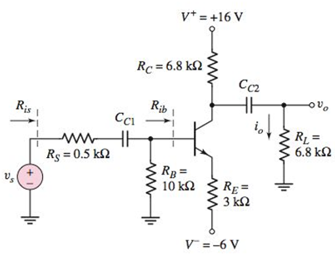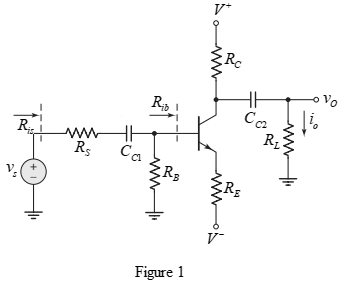
For the transistor in the circuit in Figure P6.26, the parameters are

Figure P6.26
(a)
The quiescent
Answer to Problem 6.26P
The quiescent
Explanation of Solution
Given:
The current gain
The circuit for

The circuit parameters are written below.
Concept used:
The expression for quiescent collector current is written below.
Calculation:
Apply dc analysis and KVL in base emitter loop.
Substitute
Substitute
Therefore, the quiescent collector current
Apply KVL in base collector loop.
Substitute
Therefore, the
Conclusion:
Thus, the quiescent
(b)
The hybrid
Answer to Problem 6.26P
The transconductance
Explanation of Solution
Concept used:
The expression for transconductance
The expression for diffusion resistance
The expression for output resistance
Calculation:
Substitute
Therefore, the transconductance
Substitute
Therefore, the diffusion resistance
Substitute
Therefore, the output resistance
Conclusion:
Thus, the transconductance
(c)
The small signal voltage gain
Answer to Problem 6.26P
The small signal voltage gain
Explanation of Solution
Concept used:
The expression for small signal voltage gain
The expression for small signal current gain
Calculation:
The input resistance
Substitute
Therefore, the small signal voltage gain
Substitute
Therefore, the small signal current gain
Conclusion:
Thus, the small signal voltage gain
(d)
The input resistance
Answer to Problem 6.26P
The input resistance
Explanation of Solution
Concept used:
The expression for input resistance
The expression for input resistance
Calculation:
Substitute
Therefore, the input resistance
Substitute
Therefore, the input resistance
Conclusion:
Thus, the input resistance
(e)
The small signal voltage gain
Answer to Problem 6.26P
The small signal voltage gain
Explanation of Solution
Concept used:
The expression for small signal voltage gain
Calculation:
Substitute
Therefore, the small signal voltage gain
Since, small signal current gain is independent of source resistance, so it is same as obtained in part (c).
Therefore, the small signal current gain
Conclusion:
Thus, the small signal voltage gain
Want to see more full solutions like this?
Chapter 6 Solutions
MICROELECT. CIRCUIT ANALYSIS&DESIGN (LL)
- --3/5- b) g(t) = 3 1441 g(t+mT) = g(t) -31 (i) Complex fourier coefficient Cn. (ii) Complex fourier coefficients - real fourier coefficient (the first 5 non-zero terms) of (iii) sketch the amplitude spectrum g(t) |Cal against n. n= -3 ⇒n=3 (labelling the axis).arrow_forwardQ4) (i) Calculate the fourier transform of : h(t) 2T (is) h(t) 2T -T о T 2T ·(-++T). cos2t ost≤T (iii) hro (4) ((-++T). cos otherwisearrow_forwardQ2)a) consider the Circuit in figure 2 with initial conditions of Vc (o) = 5V, I₁ (o) = 1A, (i) redraw the circuit in the frequency domain using laplace Wansforms. (ii) using this circuit derive an equation for the Voltage across the inductor in the time domain.. 3.12 ww =V/3F ZH (figure 2) d) Solve the following second order differential equation using laplace transforms. d12 + 5 dx 3x=71 dt - with initial conditions x² (0) = 2, α(0) = 1arrow_forward
- b) Another periodic waveform is defined by T c) g(t)= T with g(t+mT) = g(t) and m is an integer. (i) Sketch g(t) over two full cycles in the time domain, labelling the axes. (ii) Derive the formulae for the complex Fourier coefficients c₁ for g(t). For a periodic waveform h(t), if its complex Fourier coefficients are T T when n is odd T 2n²² T 4nn when n is even and not zero 4nn please derive the first five non-zero terms of the real Fourier series for h(t).arrow_forwardQ3)α) f(t) = (-+- 1 Isto f(t+mT) = f(t). L+- I Ost ST integer (i) sketch f(t) 2 full cycles time domain. (labelling the axis). (ii) Derive the formula for the real fourier Coefficients (i) Real Fourier series f(t), first 5 non-terms. an bn for f(t).arrow_forwardQ3. a) A periodic waveform is defined by T 3 0≤t< f(t) = SIarrow_forwardQ2. a) Sketch the following waveform f(t)=Vo -1/2≤t≤1/2 =0 otherwise and show that its Fourier transform is 2V ωτ ωτ F(s)-sinotsinc) 2 Use this result to sketch a fully labelled graph of the amplitude spectrum of a single square voltage pulse, of amplitude 24V and pulse width 1.4μs, using units of Hz for the frequency axis. (Note: graph paper is not required - a clear, fully-labelled sketch is adequate).arrow_forwardc) Another periodic waveform is defined by 4t g(t)= 0≤tarrow_forwardQ1. a) A periodic waveform is defined by f(t)= 3 0≤tarrow_forwardI have 50mV in the function generator with 10kHz. Does the connection and reading seem about right? I need to read output voltage.arrow_forwardThe solution sent previously is incorrect; I need the correct solution. An antenna with a radiation impedance of 75+j10 ohm, with 10 ohm loss resistance, is connected to a generator with open-circuit voltage of 12 v and an internal impedance of 20 ohms via a 2/4-long transmission line with characteristic impedance of 75 ohms. (a) Draw the equivalent circuit (c) Determine the power radiated by the antenna.arrow_forwardFIU Quiz: Take Quiz 1: Chapter 1 courses/217034/quizzes/1318866/take S M Inbox (40,079) - josesanchez11: X + 2. For the circuit in figure below: (a) Identify and label all distinct nodes. (b) Which of those nodes are extraordinary nodes? (c) Identify all combinations of 2 or more circuit elements that are connected in series. (d) Identify pairs of circuit elements that are connected in parallel. ww 25 Ω 12 V +1 40 Ω 10 Ω 60 Ω ww 2502 Ω 30 Ω 20 Ω 15 Ω ww Upload Choose a File X legearrow_forwardarrow_back_iosSEE MORE QUESTIONSarrow_forward_iosRecommended textbooks for you
 Introductory Circuit Analysis (13th Edition)Electrical EngineeringISBN:9780133923605Author:Robert L. BoylestadPublisher:PEARSON
Introductory Circuit Analysis (13th Edition)Electrical EngineeringISBN:9780133923605Author:Robert L. BoylestadPublisher:PEARSON Delmar's Standard Textbook Of ElectricityElectrical EngineeringISBN:9781337900348Author:Stephen L. HermanPublisher:Cengage Learning
Delmar's Standard Textbook Of ElectricityElectrical EngineeringISBN:9781337900348Author:Stephen L. HermanPublisher:Cengage Learning Programmable Logic ControllersElectrical EngineeringISBN:9780073373843Author:Frank D. PetruzellaPublisher:McGraw-Hill Education
Programmable Logic ControllersElectrical EngineeringISBN:9780073373843Author:Frank D. PetruzellaPublisher:McGraw-Hill Education Fundamentals of Electric CircuitsElectrical EngineeringISBN:9780078028229Author:Charles K Alexander, Matthew SadikuPublisher:McGraw-Hill Education
Fundamentals of Electric CircuitsElectrical EngineeringISBN:9780078028229Author:Charles K Alexander, Matthew SadikuPublisher:McGraw-Hill Education Electric Circuits. (11th Edition)Electrical EngineeringISBN:9780134746968Author:James W. Nilsson, Susan RiedelPublisher:PEARSON
Electric Circuits. (11th Edition)Electrical EngineeringISBN:9780134746968Author:James W. Nilsson, Susan RiedelPublisher:PEARSON Engineering ElectromagneticsElectrical EngineeringISBN:9780078028151Author:Hayt, William H. (william Hart), Jr, BUCK, John A.Publisher:Mcgraw-hill Education,
Engineering ElectromagneticsElectrical EngineeringISBN:9780078028151Author:Hayt, William H. (william Hart), Jr, BUCK, John A.Publisher:Mcgraw-hill Education,
 Introductory Circuit Analysis (13th Edition)Electrical EngineeringISBN:9780133923605Author:Robert L. BoylestadPublisher:PEARSON
Introductory Circuit Analysis (13th Edition)Electrical EngineeringISBN:9780133923605Author:Robert L. BoylestadPublisher:PEARSON Delmar's Standard Textbook Of ElectricityElectrical EngineeringISBN:9781337900348Author:Stephen L. HermanPublisher:Cengage Learning
Delmar's Standard Textbook Of ElectricityElectrical EngineeringISBN:9781337900348Author:Stephen L. HermanPublisher:Cengage Learning Programmable Logic ControllersElectrical EngineeringISBN:9780073373843Author:Frank D. PetruzellaPublisher:McGraw-Hill Education
Programmable Logic ControllersElectrical EngineeringISBN:9780073373843Author:Frank D. PetruzellaPublisher:McGraw-Hill Education Fundamentals of Electric CircuitsElectrical EngineeringISBN:9780078028229Author:Charles K Alexander, Matthew SadikuPublisher:McGraw-Hill Education
Fundamentals of Electric CircuitsElectrical EngineeringISBN:9780078028229Author:Charles K Alexander, Matthew SadikuPublisher:McGraw-Hill Education Electric Circuits. (11th Edition)Electrical EngineeringISBN:9780134746968Author:James W. Nilsson, Susan RiedelPublisher:PEARSON
Electric Circuits. (11th Edition)Electrical EngineeringISBN:9780134746968Author:James W. Nilsson, Susan RiedelPublisher:PEARSON Engineering ElectromagneticsElectrical EngineeringISBN:9780078028151Author:Hayt, William H. (william Hart), Jr, BUCK, John A.Publisher:Mcgraw-hill Education,Diode Logic Gates - OR, NOR, AND, & NAND; Author: The Organic Chemistry Tutor;https://www.youtube.com/watch?v=9lqwSaIDm2g;License: Standard Youtube License
Engineering ElectromagneticsElectrical EngineeringISBN:9780078028151Author:Hayt, William H. (william Hart), Jr, BUCK, John A.Publisher:Mcgraw-hill Education,Diode Logic Gates - OR, NOR, AND, & NAND; Author: The Organic Chemistry Tutor;https://www.youtube.com/watch?v=9lqwSaIDm2g;License: Standard Youtube License